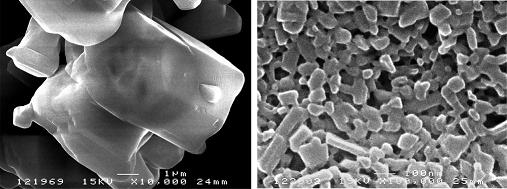Home > Press > Nano-particle suspension in pharmaceutical mixing
 |
| Image shows phenytoin before (x10,000) and after (x100,000) thinky mixing |
Abstract:
Thinky mixers from Intertronics create nano-particle suspensions of medical compounds more reliably and quicker than traditional methods
Nano-particle suspension in pharmaceutical mixing
UK | Posted on May 11th, 2010A new clever mixing process is announced by the people at Intertronics using the Thinky ARV-310 and Thinky ARV-5000 industrial non-contact "planetary" mixers for engineering compounds. In particular these machines are excellent in creating nano-particle suspensions of medical compounds more reliably and quicker than traditional methods. This can often overcome problems of dilution where materials have negligible water solubility and they enable mixing, dispersal and degassing in amounts as small as 0.5ml, up to large, laboratory level quantities.
The new process involves use of a Thinky mixer with zirconia balls which can pulverize poorly water soluble compounds such as medical drug doses using the over 2000 rpm planetary technology. In addition use of the ARV vacuum mixer enables complete elimination of all air bubbles. Commonly a pestle and mortar are used for oral dosage formulations. While this method is generally accepted and effective, this hand process is tedious and tiring, and lacks any degree of repeatability or consistent quality. The new technique is called "nh-Step". The nh-Step makes the mixing process easy, fast, improves physiochemical properties and it can be applied to many oral suspensions. For example, with an initial particle size of 18 micron, utilizing the "nh-Step" process the particle distribution was reduced to 2 microns after only 3 minutes with the Thinky's ARE-250.
The Thinky ARV-310 and Thinky ARV-5000 have the ability to process under vacuum, or under normal pressure, or even automatically switching into vacuum mode from non-vacuum state during the process. It is possible to set the desired vacuum level for different types of ingredients. For high-viscosity materials and materials for which a high degree of de-aeration is required, these are ideal mixers. These mixers can eliminate micron-sized bubbles, without the danger of foaming and messy spillage.
Further information regarding Intertronics' products can be found at www.intertronics.co.uk.
####
For more information, please click here
Contacts:
Peter Swanson
00 44 (0)1865 842842
Copyright © Intertronics
If you have a comment, please Contact us.Issuers of news releases, not 7th Wave, Inc. or Nanotechnology Now, are solely responsible for the accuracy of the content.
| Related News Press |
News and information
![]() Researchers develop molecular qubits that communicate at telecom frequencies October 3rd, 2025
Researchers develop molecular qubits that communicate at telecom frequencies October 3rd, 2025
![]() Next-generation quantum communication October 3rd, 2025
Next-generation quantum communication October 3rd, 2025
![]() "Nanoreactor" cage uses visible light for catalytic and ultra-selective cross-cycloadditions October 3rd, 2025
"Nanoreactor" cage uses visible light for catalytic and ultra-selective cross-cycloadditions October 3rd, 2025
Nanomedicine
![]() New molecular technology targets tumors and simultaneously silences two ‘undruggable’ cancer genes August 8th, 2025
New molecular technology targets tumors and simultaneously silences two ‘undruggable’ cancer genes August 8th, 2025
![]() New imaging approach transforms study of bacterial biofilms August 8th, 2025
New imaging approach transforms study of bacterial biofilms August 8th, 2025
![]() Cambridge chemists discover simple way to build bigger molecules – one carbon at a time June 6th, 2025
Cambridge chemists discover simple way to build bigger molecules – one carbon at a time June 6th, 2025
![]() Electrifying results shed light on graphene foam as a potential material for lab grown cartilage June 6th, 2025
Electrifying results shed light on graphene foam as a potential material for lab grown cartilage June 6th, 2025
Materials/Metamaterials/Magnetoresistance
![]() First real-time observation of two-dimensional melting process: Researchers at Mainz University unveil new insights into magnetic vortex structures August 8th, 2025
First real-time observation of two-dimensional melting process: Researchers at Mainz University unveil new insights into magnetic vortex structures August 8th, 2025
![]() Researchers unveil a groundbreaking clay-based solution to capture carbon dioxide and combat climate change June 6th, 2025
Researchers unveil a groundbreaking clay-based solution to capture carbon dioxide and combat climate change June 6th, 2025
![]() A 1960s idea inspires NBI researchers to study hitherto inaccessible quantum states June 6th, 2025
A 1960s idea inspires NBI researchers to study hitherto inaccessible quantum states June 6th, 2025
![]() Institute for Nanoscience hosts annual proposal planning meeting May 16th, 2025
Institute for Nanoscience hosts annual proposal planning meeting May 16th, 2025
Announcements
![]() Rice membrane extracts lithium from brines with greater speed, less waste October 3rd, 2025
Rice membrane extracts lithium from brines with greater speed, less waste October 3rd, 2025
![]() Researchers develop molecular qubits that communicate at telecom frequencies October 3rd, 2025
Researchers develop molecular qubits that communicate at telecom frequencies October 3rd, 2025
![]() Next-generation quantum communication October 3rd, 2025
Next-generation quantum communication October 3rd, 2025
![]() "Nanoreactor" cage uses visible light for catalytic and ultra-selective cross-cycloadditions October 3rd, 2025
"Nanoreactor" cage uses visible light for catalytic and ultra-selective cross-cycloadditions October 3rd, 2025
Tools
![]() Japan launches fully domestically produced quantum computer: Expo visitors to experience quantum computing firsthand August 8th, 2025
Japan launches fully domestically produced quantum computer: Expo visitors to experience quantum computing firsthand August 8th, 2025
![]() Rice researchers harness gravity to create low-cost device for rapid cell analysis February 28th, 2025
Rice researchers harness gravity to create low-cost device for rapid cell analysis February 28th, 2025
|
|
||
|
|
||
| The latest news from around the world, FREE | ||
|
|
||
|
|
||
| Premium Products | ||
|
|
||
|
Only the news you want to read!
Learn More |
||
|
|
||
|
Full-service, expert consulting
Learn More |
||
|
|
||








